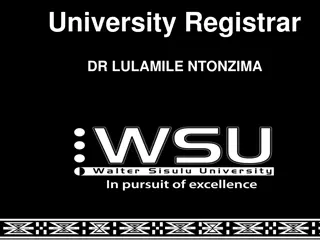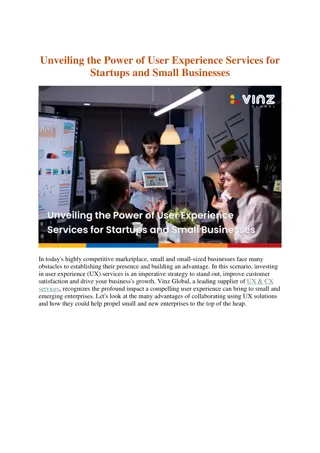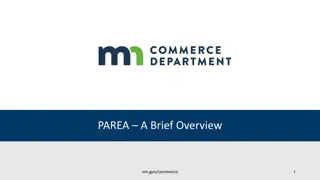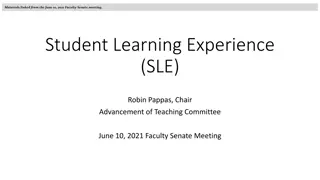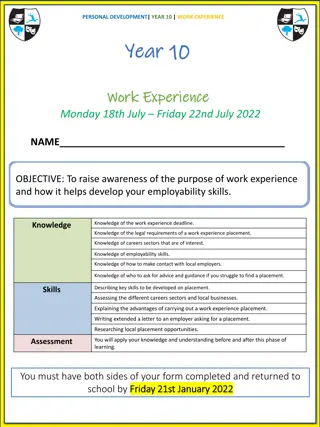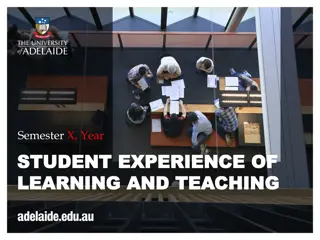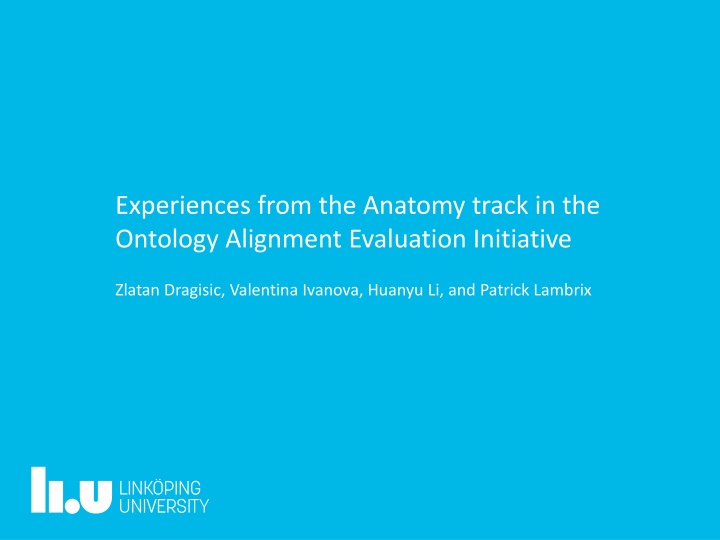
Anatomy Track in Ontology Alignment Evaluation Initiative
"Explore experiences and insights from the Anatomy track in the Ontology Alignment Evaluation Initiative, focusing on overlapping ontologies, data integration, agent communication, and bottom-up ontology development for improved alignment. Learn about the initiative's goals, evaluation methods, participating systems, and evolution of ontologies since 2005 in the biomedical domain."
Download Presentation

Please find below an Image/Link to download the presentation.
The content on the website is provided AS IS for your information and personal use only. It may not be sold, licensed, or shared on other websites without obtaining consent from the author. If you encounter any issues during the download, it is possible that the publisher has removed the file from their server.
You are allowed to download the files provided on this website for personal or commercial use, subject to the condition that they are used lawfully. All files are the property of their respective owners.
The content on the website is provided AS IS for your information and personal use only. It may not be sold, licensed, or shared on other websites without obtaining consent from the author.
E N D
Presentation Transcript
Experiences from the Anatomy track in the Ontology Alignment Evaluation Initiative Zlatan Dragisic, Valentina Ivanova, Huanyu Li, and Patrick Lambrix
Ontology Alignment Overlapping ontologies; Data integration and sharing; Agent communication; Bottom-up development of new ontologies;
Introduction Ontology Alignment Evaluation Initiative started in 2004 as a part of the Ontology Matching Workshop Goals: assessing strengths and weaknesses of alignment/matching systems comparing performance of techniques increase communication among algorithm developers improve evaluation techniques most of all, helping improving the work on ontology alignment/matching
Introduction contd New tracks/problems Improvements on existing tracks New evaluation methods (SEALS 2010) Since 2010 systems are evaluated on all tracks Both blind/non-blind tests Some tracks: Anatomy Benchmark Conference Multifarm LargeBio Instance matching
Anatomy track One of the longest running tracks since 2005 Ontologies in the biomedical domain Foundational Model of Anatomy and OpenGalen Anatomy Model 2005-2006 Since 2007 - A part of NCI Thesaurus human anatomy and Adult Mouse Anatomy ontology
Outline The data set and tasks Participating systems Results for different tasks Summary and future directions
The data set - ontologies First version in 2007: AMA - 2744 concepts and 3 object properties ca 4500 is-a relations ca 3500 annotations A fragment of NCI-A 3304 concepts and 2 object properties ca 5500 is-a relations Ca 15000 annotations Minor changes to ontologies in 2010
The data set reference alignment Alignment as a part of a project to enable linking these ontologies Manually curated by domain experts Initially 1544 equivalence relations Refined in 2008 and 2010 to current 1516 equivalence relations More work is needed to guarantee its correctness
Performance measures Precision Recall F-measure ????????? ?????? ? ?????????+?????? ??= (1 + ?) Recall+ - recall of non-trivial correspondences Runtime
Tasks Task 1: optimize F-measure Task 2 : optimize F-measure with a focus on precision Task 3: optimize F-measure with a focus on recall Task 4: optimize F-measure given a partial reference alignment (50 non-trivial correspondences) Interactive track: using an oracle (which may make mistakes)
Evaluation 2007-2010: tests were done blind authors submitted their alignment 2010-2016: reference alignment available since 2011 evaluation done through the SEALS framework organizers run the tools
Outline The data set and tasks Participating systems Results for different tasks Summary and future directions
Participating systems Since 2011 all tools are evaluated in all tracks Some tools participate with different versions A number of tools participate often, e.g.: Lily, LogMap 6 Aroma 5 AgreementMaker, AML, ASMOV, MaasMatch, TaxoMap, XMap - 4
Overview framework of Ontology Alignment instance corpus general dictionary domain thesaurus matchermatcher matcher o n t o l o g i e s a l i g n m e n t Preprocessing combination filter I II mapping suggestions user accepted and suggestions conflict rejected checker
Basic processes of participating systems Preprocessing Data preparation Reduction of search space Matching Combination Filtering Debugging User Interaction
Matching strategies of participating systems String-based Edit-Distance, Jaccard, Soft Jaccard, Soft TF-IDF Structure-based Similarity propagation, Similarity flooding Constraint-based Domain restriction Instance-based Rarely used in Anatomy track
Combination Weighted Sum-based or Maximum-based selection Weighted Sum-based: weighted sum of similarities of different matchers Maximum-based: maximum of similarity of different matchers Advanced approaches Neural network, Genetic algorithm, Clustering algorithm, Overlap of different matchers
Filtering Single Threshold Only define a lower boundary Double Threshold To define the lower and the upper boundaries to filter matching result Advanced approaches Maximum Entropy Approach Stable Marriage Algorithm
Use of auxiliary information by participating systems Biomedical resources UMLS (Unified Medical Language System) used by 9 systems Uberon used by 5 systems BioPortal used by 1 system MeSH (Medical Subject Headings) used by 1 system FMA (Foundational Model of Anatomy) used by 2 systems Non-biomedical resources WordNet (25 systems), WikiPedia, Google, Apache Lucene
Findings Processes Preprocessing Matching Combination Filtering Matching strategies All systems use string-based strategies Most systems implement structure-based strategies Some systems implement constraint-based strategies Instance-based approaches are not often used in the Anatomy track Many systems implement this step and most of them have this step for data preparation Weighted sum is most common approach Most common approach is single threshold
Findings Use of auxiliary information WordNet is most often used In terms of biomedical background knowledge, UMLS is the most used resource
Outline The data set and tasks Participating systems Results for different tasks Summary and future directions
Evaluation of the OAEI task 1 results We collected reported results (precision/recall/F- measure) for the tools in 2007-2009 Alignment files were collected for the period 2010- 2016 and revaluated on the most recent version of the ontologies/reference alignment Analysis of most common mistakes and least commonly found correspondences
Task 1 recall/F-measure/precision Precision Recall F-measure 2007 2011 - Steady increase in F-measure (due to improvements in precision) 2011 all systems evaluated in all tracks Since 2011 stable precision, slight drop in recall Since 2013 AML best performing system
Task 1 recall+ Recall+ evaluates the ability of the tool to find non-trivial correspondences Little improvement over the years (best results do improve) Tools that use auxiliary sources achieve better results Best tools still do not find ca 20% of non- trivial correspondences
Task 1 - Coherence of the produced alignment Evaluated since 2010 Evaluates if the merged ontologies and the alignment produce a coherent ontology (no unsatisfiable classes) Positive trend in recent years
Task 1 runtimes Evaluated since 2007 except in 2010 Initially reported by the authors From 2007-2009 median decreased from 4.5 h (2007) to 11 min (2009) From 2011 and on no obvious trend No correlation between runtimes and the quality of the alignment Median runtimes
Aggregated results 2010-2016 When using more systems recall/recall+ is better than the best system for that year Top3 in 2010 and top3 in 2011 have better F- measure than the best systems for those year Union-all shows that there are still correspondences which were not found by any system
Analysis of the found correspondences Analysis of least commonly found correct correspondences: Cannot be identified using simple string matching Some mistakes in the reference alignment/ontologies Analysis of most common mistakes w.r.t. the reference alignment: Usually similar labels Concepts which are related via other relations, such as part of or subsumption relation Some mistakes in the reference alignment/ontologies
Tasks 2 and 3 Run 4 times (2007-2010) Most systems could be optimized with a focus on recall/precision In all cases increase in precision/recall meant decrease in the other measure Most common approach using different thresholds Some systems use additional heuristics
Task 4 Partial reference alignment ca 50 non-trivial correspondences and all trivial ones During 3 years (2008-2010) 8 systems participated All systems achieved improvement in precision Some systems (SAMBO) showed increase in recall The task inspired other work
Interactive track Since 2015 User interaction simulated using an oracle in the SEALS client Different error rates: 0.0, 0.1, 0.2 and 0.3 6 participating systems implementing different strategies Evaluated on precision/F-measure/recall as well as number of interactions F-measure improved (in most case even in presence of errors)
Outline The data set and tasks Participating systems Results for different tasks Summary and future directions
Summary of findings Average 10 to 15 systems participate Systems participating often improve results Many systems implement a preprocessing step Data preparation Reducing search space Many systems implement multiple matching strategies (all use string-matching) More and more systems check for the coherence of the proposed alignment Substantial improvements in F-measure (lately mostly due to improvements in recall) Interaction benefits the quality of the alignment
Possible changes and directions Update of the ontologies and the reference alignment Repair of the reference alignment Considering other types of relationships (part-of and subsumption relations) Improving the documentation provided by the tools





